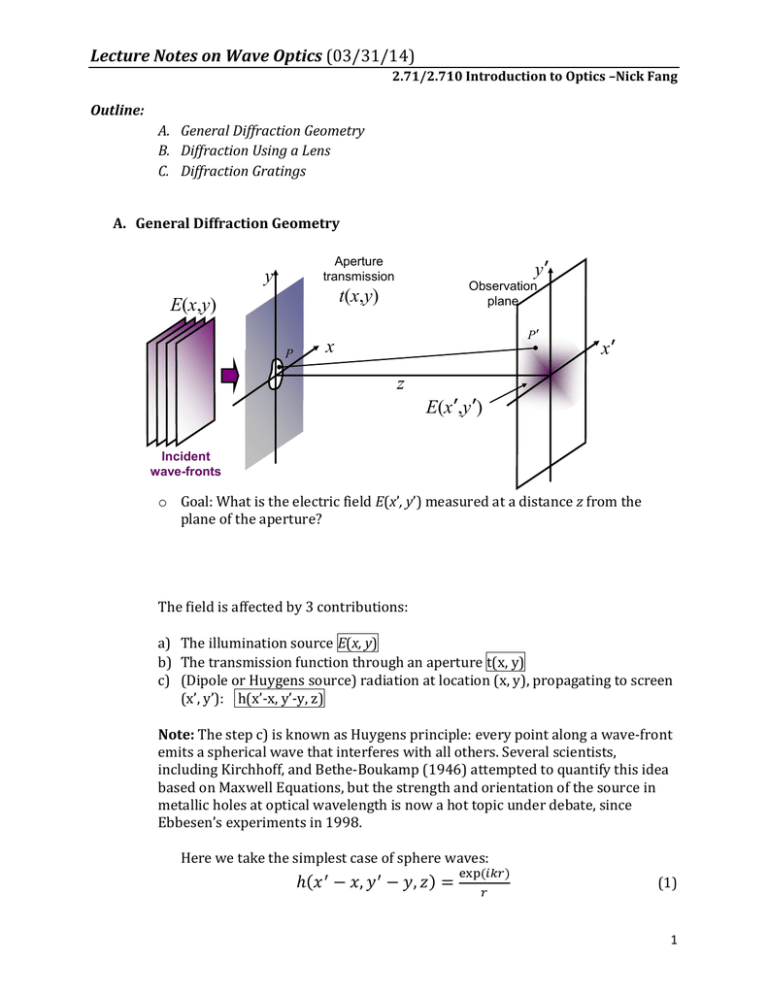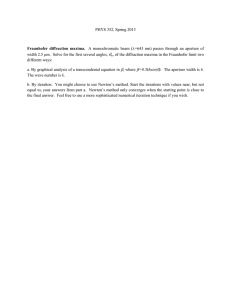
Lecture Notes on Wave Optics (03/31/14)
2.71/2.710 Introduction to Optics –Nick Fang
Outline:
A. General Diffraction Geometry
B. Diffraction Using a Lens
C. Diffraction Gratings
A. General Diffraction Geometry
Aperture
transmission
y
y’
Observation
plane
t(x,y)
E(x,y)
P
P’
x
x’
z
E(x’,y’)
Incident
wave-fronts
o Goal: What is the electric field E(x’, y’) measured at a distance z from the
plane of the aperture?
The field is affected by 3 contributions:
a) The illumination source E(x, y)
b) The transmission function through an aperture t(x, y)
c) (Dipole or Huygens source) radiation at location (x, y), propagating to screen
(x’, y’): h(x’-x, y’-y, z)
Note: The step c) is known as Huygens principle: every point along a wave-front
emits a spherical wave that interferes with all others. Several scientists,
including Kirchhoff, and Bethe-Boukamp (1946) attempted to quantify this idea
based on Maxwell Equations, but the strength and orientation of the source in
metallic holes at optical wavelength is now a hot topic under debate, since
Ebbesen’s experiments in 1998.
Here we take the simplest case of sphere waves:
ℎ(𝑥 ′ − 𝑥, 𝑦 ′ − 𝑦, 𝑧) =
exp(𝑖𝑘𝑟)
𝑟
(1)
1
Lecture Notes on Wave Optics (03/31/14)
2.71/2.710 Introduction to Optics –Nick Fang
𝑟 = √(𝑥 ′ − 𝑥)2 + (𝑦′ − 𝑦)2 + 𝑧 2
where
(2)
The resulting field is then a convolution of all the three factors:
𝐸(𝑥 ′ , 𝑦 ′ ) = ∬ ℎ(𝑥 ′ − 𝑥, 𝑦 ′ − 𝑦, 𝑧)𝑡(𝑥, 𝑦)𝐸(𝑥, 𝑦)𝑑𝑥𝑑𝑦
(3)
o Fraunhoffer diffraction: Far field (z>>x’, y’, x, y)
𝑟 = √(𝑥 ′ − 𝑥)2 + (𝑦′ − 𝑦)2 + 𝑧 2
𝑟 ≈ 𝑧(1 +
(𝑥 ′ −𝑥)2 +(𝑦 ′ −𝑦)2
2𝑧 2
𝑥𝑥 ′ +𝑦𝑦 ′
𝑧
(4)
(𝑥 ′ − 𝑥)2 + (𝑦 ′ − 𝑦)2
)
2𝑧
exp(𝑖𝑘𝑟) ≈ exp(𝑖𝑘𝑧 + 𝑖𝑘
≈ exp(𝑖𝑘𝑧)𝑒𝑥𝑝(−𝑖𝑘
)
)exp(𝑖𝑘
2
2
𝑥 ′ +𝑦 ′ +𝑥 2 +𝑦 2
2𝑧
)
(5)
(up to here, it is Fresnel condition for diffraction)
Now if we further assume the quadratic terms are negligible:
(Fraunhofer condition, difficult to achieve!)
2
2
𝑘(𝑥 ′ +𝑦 ′ )
2𝑧
≪ 1,
𝑘(𝑥 2 +𝑦 2 )
2𝑧
≪1
(6)
Then we have a set of plane waves (rays) launched at x, y:
𝑒𝑥𝑝(−𝑖𝑘
𝑥𝑥 ′ +𝑦𝑦 ′
𝑧
) ≈ exp(−𝑖𝑘(𝜃𝑥 ′ 𝑥 + 𝜃𝑦′ 𝑦))
𝑥′
𝑦′
𝑥′
𝑦′
𝑧
𝑧
𝑧
𝑧
𝜃𝑥 ′ ≈ , 𝜃𝑦′ ≈ , or 𝑘𝑥 ≈ 𝑘 , 𝑘𝑦 ≈ 𝑘
1
𝐸(𝑥 ′ , 𝑦 ′ ) ≈ ∬ exp(−𝑖𝑘(𝜃𝑥 ′ 𝑥 + 𝜃𝑦′ 𝑦))𝑡(𝑥, 𝑦)𝐸(𝑥, 𝑦)𝑑𝑥𝑑𝑦
𝑧
What we measure at the far field is a Fourier transform of t(x,y)E(x,y)!
(7)
(8)
2
Lecture Notes on Wave Optics (03/31/14)
2.71/2.710 Introduction to Optics –Nick Fang
Practice problem: Find the Fraunhofer diffraction pattern of a triangular aperture as
shown in the following figure. The edges of the triangle are expressed at x=a, y=x, and
y=-x, respectively. The screen is placed at z=z0.
© Source unknown. All rights reserved. This content is
excluded from our Creative Commons license. For more
information, see http://ocw.mit.edu/fairuse.
Hint: In this case, the aperture along the y direction depends on the position x. So we
may integrate first along the y direction, and then along x-direction in the next.
3
Lecture Notes on Wave Optics (03/31/14)
2.71/2.710 Introduction to Optics –Nick Fang
h(x, y)
B. Diffraction using a lens
d
A lens introduces a phase delay
proportional to its thickness h, at a given
point (x, y):
R
𝑡(𝑥, 𝑦) = exp[𝑖𝑘(𝑛 − 1)ℎ(𝑥, 𝑦)] (9)
ℎ(𝑥, 𝑦) = √[𝑅2 − (𝑥 2 + 𝑦 2 )] − 𝑑 (10)
In the thin lens limit, we find:
ℎ(𝑥, 𝑦) ≈ 𝑅[1 − (𝑥 2 + 𝑦 2 )/2𝑅2 ] − 𝑑
(11)
𝑡(𝑥, 𝑦) ≈ exp{𝑖𝑘(𝑛 − 1)[𝑅 − 𝑑 − (𝑥 2 + 𝑦 2 )/2𝑅]}
(12)
𝑡(𝑥, 𝑦) ≈ exp[𝑖𝑘(𝑛 − 1)(𝑅 − 𝑑)] × 𝑒𝑥𝑝[−𝑖𝑘(𝑛 − 1)(𝑥 2 + 𝑦 2 )/2𝑅]
𝑡(𝑥, 𝑦) ≈ exp[𝑖𝑘(𝑛 − 1)(𝑅 − 𝑑)] × 𝑒𝑥𝑝 [−𝑖𝑘
(𝑥 2 +𝑦 2 )
2𝑓
]
(13)
(14)
1/𝑓 ≡ (𝑛 − 1)/𝑅
∆≡ (𝑛 − 1)(𝑅 − 𝑑) → 0 (thin lens)
𝑥𝑥 ′ + 𝑦𝑦 ′
exp(𝑖𝑘𝑟) 𝑡(𝑥, 𝑦) ≈ exp(𝑖𝑘(𝑧 + ∆)) exp (−𝑖𝑘
)
𝑧
1
𝑒𝑥𝑝 [𝑖𝑘(𝑥 2 + 𝑦 2 ) (
2𝑧
−
1
2𝑓
)] 𝑒𝑥𝑝 [𝑖𝑘 (
𝑥 ′2 +𝑦 ′2
2𝑧
)]
(15)
The quadratic term of 𝑥 2 + 𝑦 2 will vanish, provided that:
1
1
−
= 0, 𝑜𝑟𝑧 = 𝑓
2𝑧 2𝑓
You can apply the same argument to the quadratic phase term of (𝑥′2 + 𝑦 ′2 ) by
placing the screen at z=f away from the lens.
We’ll see the Fourier Transform of E(x. y) (Fraunhofer diffraction) by placing the
aperture and a screen at the focal planes of a lens, even it is not far away!
4
Lecture Notes on Wave Optics (03/31/14)
Screen
Screen
2.71/2.710 Introduction to Optics –Nick Fang
F
F
z
z
f
f
A.S.
13
or
A.S.
f
f
14
Note: This is consistent with our previous analysis based on ray optics. For a set of
diverging ray vectors (x, ) that emerge from the aperture at the front focal plane,
the lens converts the rays to a set of parallel beams. At the back focal plane, we
measure a set of new ray vectors (x’, ’):
1
𝑥′
(𝜃′
)=[
0
1
𝑓
][
1 −1/𝑓
0 1
][
1 0
0
𝑓 𝑥
] (𝜃 ) = [
−1/𝑓
1
𝑓 𝑥
]( )
0 𝜃
(16)
In another word, geometric optics addresses the propagation (or optimal optical
path length) from aperture stop to the screen appropriately. The effect of
diffraction is reduced to Huygens principle, or how the “secondary” field emerges
right behind the aperture.
C. Diffraction Gratings
A diffraction grating is a slab with a periodic modulation of any sort on one of its
surfaces. The modulation can be in the form of transmission, reflection, or the phase
delay of a beam.
For example, let’s begin with a sinusoidal modulation of the transmission
function:
2𝜋𝑥
𝑡(𝑥, 𝑦) = 𝑡0 + 𝑡1 𝑐𝑜𝑠 ( )
(17)
Λ
the Fraunhofer diffracted field is:
Λ
incident
plane
wave
𝐸(𝑥 ′ , 𝑦 ′ ) ≈
exp(𝑖𝑘𝑧)
∬ exp(−𝑖𝑘𝑥 𝑥 − 𝑖𝑘𝑦 𝑦))𝑡(𝑥, 𝑦)𝐸(𝑥, 𝑦)𝑑𝑥𝑑𝑦
𝑧
(18)
5
Lecture Notes on Wave Optics (03/31/14)
2.71/2.710 Introduction to Optics –Nick Fang
What if the periodic modulation of the transmission is not sinusoidal, e.g. a
square modulation?
Since it's periodic, we can use a Fourier series for it (or consider a comb function in
convolution with the square windows):
𝑡(𝑥 ) = ∑∞
𝑚=0 𝑡𝑚 𝑐𝑜𝑠 (
2𝜋𝑚𝑥
Λ
)
(19)
An order of a diffraction grating occurs if:
𝑘𝑥 = 𝑚
2𝜋
Λ
, or Λsin(𝜃𝑚 ) = 𝑚𝜆,
(20)
where m is an integer. The above equation assumed normal incidence.
Phase grating: In the case for phase grating, we may modulate the beams by
varying the phase delay of incident beam through a set of patterns on
transparent window.
For example, let’s look at a binary grating with modulation of the
phase function:
(21)
𝑡(𝑥) = exp(𝑖𝑘(𝑛 − 1)ℎ(𝑥))
𝑥
𝑥
ℎ(𝑥) = ℎ × 𝑟𝑒𝑐𝑡 ( ) ⨂𝑐𝑜𝑚𝑏 ( ) << 𝜆
(22)
h
G
𝑊
𝐺
the 1D Fraunhofer diffracted field is: (assuming E(x)=1)
incident
plane
wave
𝐸(𝑥 ′ ) ≈ ∫ exp(−𝑖𝑘𝑥 𝑥) 𝑡(𝑥)𝑑𝑥
𝐸(𝑥 ′ ) ≈ ∫ exp(−𝑖𝑘𝑥 𝑥) [1 + 𝑖𝑘(𝑛 − 1)ℎ(𝑥)]𝑑𝑥
(23)
(24)
glass
refractive index n
𝑥
𝑥
𝑊
𝐺
𝐸(𝑘𝑥 ) ≈ 𝛿(𝑘𝑥 ) + 𝑖𝑘(𝑛 − 1) ∫ exp(−𝑖𝑘𝑥 𝑥) [ℎ × 𝑟𝑒𝑐𝑡 ( ) ⨂𝑐𝑜𝑚𝑏 ( )] 𝑑𝑥
𝐺
𝐸(𝑥 ′ ) ≈ 𝛿(𝑘𝑥 ) + 𝑖𝑘(𝑛 − 1)ℎ[𝑊𝑠𝑖𝑛𝑐(𝑊𝑘𝑥 )]𝑐𝑜𝑚𝑏(
2𝜋
𝑘𝑥 )
(25)
(26)
6
MIT OpenCourseWare
http://ocw.mit.edu
2SWLFV
Spring 2014
For information about citing these materials or our Terms of Use, visit: http://ocw.mit.edu/terms.



